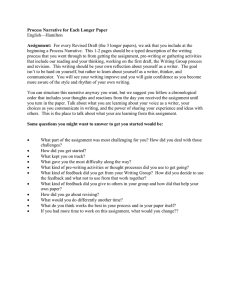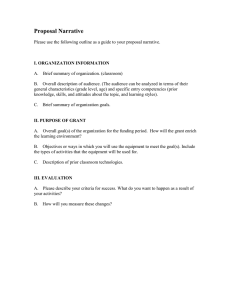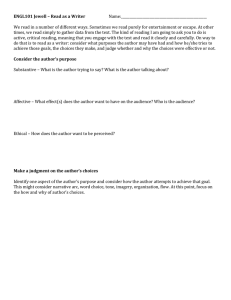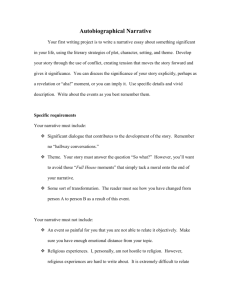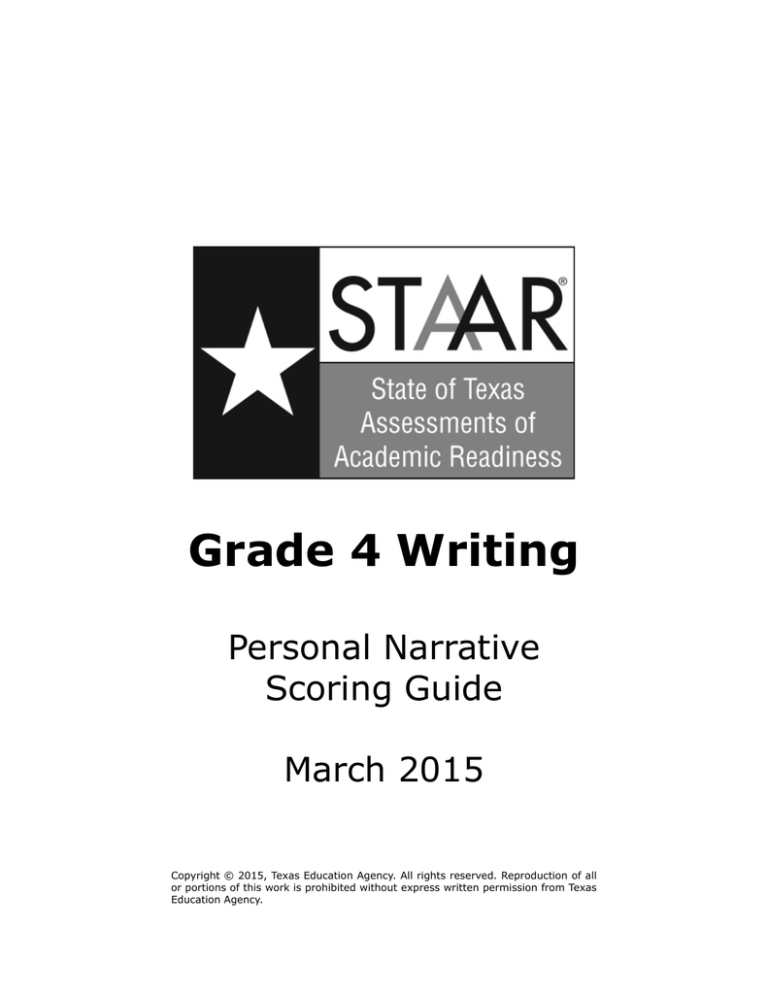
Grade 4 Writing
Personal Narrative
Scoring Guide
March 2015
Copyright © 2015, Texas Education Agency. All rights reserved. Reproduction of all
or portions of this work is prohibited without express written permission from Texas
Education Agency.
Grade 4 Writing
Personal Narrative Prompt
© digitalmedianjb/Bigstock.com
Look at the picture below.
Sometimes we can do anything if we are determined.
Write about a time when you tried your hardest.
Be sure to —
• write about a personal experience
• organize your writing
• develop your ideas in detail
• choose your words carefully
• use correct spelling, capitalization, punctuation, grammar, and sentences
STAAR Grade 4 Personal Narrative
Score Point 1
The narrative represents a very limited writing performance.
Organization/Progression
The form or structure of the narrative is inappropriate to the purpose or the
specific demands of the prompt. The writer uses organizational strategies or
literary devices that are only marginally suited to the narrative task, or they
are inappropriate or not evident at all. Because the narrative is presented in
a random or illogical way, the writer is not able to convey a sense of the
experience.
Many of the details do not contribute to the narrative. The writer’s lack of
focus on a specific personal experience weakens the unity and coherence of
the narrative.
The writer’s narrative presentation is weak. Repetition or wordiness
sometimes causes serious disruptions in the story line. At other times the
lack of transitions and sentence-to-sentence connections makes one or more
parts of the narrative unclear or difficult to follow.
Development of Ideas
The development of the narrative is weak because the details are
inappropriate, vague, or insufficient. They do not contribute to the writer’s
portrayal of the experience.
The narrative is insubstantial because the writer’s response to the prompt is
vague or confused. In some cases, the narrative as a whole is only weakly
linked to the prompt. In other cases, the writer fails to establish a realistic
situation or present motivations for behavior or actions.
Use of Language/Conventions
The writer’s word choice may be vague or limited. It reflects little or no
awareness of the narrative purpose. The word choice impedes the writer’s
ability to relate the experience clearly.
Sentences are simplistic, awkward, or uncontrolled, weakening the
effectiveness of the narrative.
The writer has little or no command of sentence boundaries and ageappropriate spelling, capitalization, punctuation, grammar, and usage
conventions. Serious and persistent errors create disruptions in the fluency of
the writing and sometimes interfere with meaning.
Texas Education Agency
Student Assessment Division
March 2015
STAAR Grade 4
March 2015
Personal Narrative — 1
Score Point 1
Although the writer briefly establishes a narrative intent in the opening sentence (One
time I tried my hardest just to play basketball), he does not write about a specific
personal experience. Instead, he develops the response with a series of general statements
about playing basketball, focused mostly on where he likes to play and what he does
during basketball practice. Because the composition is written as an expository piece
rather than as a personal narrative, the development is inappropriate to the specific
demands of the prompt. For this reason, the response represents a very limited writing
performance.
STAAR Grade 4
March 2015
Personal Narrative — 2
Score Point 1
This response is focused on a time the writer learned how to drive a go-kart. Although
the response is written in a narrative form, the development is general, and the
transitions used to move through time are limited to “so” and “so then.” However,
the most serious problems are at the sentence and word levels. The lack of sentence
boundaries within paragraphs reveals the writer’s inability to construct basic sentences,
which seriously weakens the narrative. In addition, the errors in word usage (“into” for
“until”) and the misspellings of basic words further contribute to the weak control of
conventions. The result is a very limited writing performance.
STAAR Grade 4
March 2015
Personal Narrative — 3
Score Point 1
In this very limited response, the writer focuses primarily on her anxiety about doing well at her dance
recital at age eight. While this approach is appropriate to the narrative task, a lack of transitions and
sentence-to-sentence connections leaves the reader without the context or direction necessary to navigate
the internal monologue that comprises most of the story (NEVEST oh my oh my OH my! I can’t do
this! WHY WHY Im…NEVEST Thoughts in my Hade or going “I can do it”). Because these gaps
create disruptions in the story line, the response conveys only a vague sense of the writer’s experience.
In addition, the lack of appropriate punctuation between sentences causes sentence boundary problems,
and errors in the spelling of basic words further detracts from the fluency of the piece.
STAAR Grade 4
March 2015
Personal Narrative — 4
Score Point 1
The writer recounts a time when passing a test was hard. While the response does
move through time, repetition and wordiness about the test being very hard stalls the
narrative presentation. In addition, the details the writer includes about taking the test
are insufficient, preventing him from even minimally portraying the experience. The
disruptions in the storyline and weak development, along with vague language and
simplistic sentences, result in a very limited personal narrative.
STAAR Grade 4 Personal Narrative
Score Point 2
The narrative represents a basic writing performance.
Organization/Progression
The form or structure of the narrative is evident but may not always be
appropriate to the purpose or responsive to the specific demands of the
prompt. The writer uses organizational strategies or literary devices that are
only somewhat suited to the narrative task. The writer is able to convey
some sense of the experience.
Some details do not contribute to the narrative. The writer may focus on a
specific personal experience but may not sustain that focus, limiting the unity
and coherence of the narrative.
The writer’s narrative presentation is inconsistent. Sometimes repetition or
wordiness causes minor disruptions in the story line. At other times
transitions and sentence-to-sentence connections are too perfunctory or
weak to support the logical movement of the narrative.
Development of Ideas
The development of the narrative is minimal and remains at a surface level
because there are few details, they are not always appropriate, or they are
too general. For the most part, the details contribute only marginally to the
writer’s portrayal of the experience.
The narrative reflects little or no thoughtfulness. In some cases, the writer’s
response to the prompt is formulaic and demonstrates only a limited
understanding of the writing task. In other cases, the writer establishes some
elements of a realistic situation but may provide few motivations for behavior
or actions. The narrative conveys little sense of why the experience was
important to the writer.
Use of Language/Conventions
The writer’s word choice may be general or imprecise. It reflects a basic
awareness of the narrative purpose. The word choice limits the writer’s ability
to relate the experience clearly.
Sentences are awkward or only somewhat controlled, limiting the
effectiveness of the narrative.
The writer demonstrates a partial command of sentence boundaries and ageappropriate spelling, capitalization, punctuation, grammar, and usage
conventions. Some distracting errors may be evident, at times creating minor
disruptions in the fluency or meaning of the writing.
Texas Education Agency
Student Assessment Division
March 2015
STAAR Grade 4
March 2015
Personal Narrative — 5
Score Point 2
The writer begins her narrative by stating that she did her best to achieve her goal of
learning how to swim and dive. Minimal details about this experience (the beautiful
blue water was cold; Ms. Blake took hold of my arms and legs; Ms. Blake showed
me how to dive for the toys) provide some surface-level development. In addition,
the writer briefly addresses both her excitement and nervousness, which conveys some
sense of the experience. However, the conclusion does not contribute to the storyline,
and briefly presented details as well as the writer’s use of general language (very nice,
had a lot of fun) result in a basic writing performance.
STAAR Grade 4
March 2015
Personal Narrative — 6
Score Point 2
In this basic writing performance, the writer recalls scoring the winning goal in the
last soccer game of the season. The writer maintains an appropriate narrative form,
developing the response with a step-by-step account of the day’s activities. However,
most of the details the writer includes in the first half of the response (waking
up, brushing his teeth, eating breakfast, changing clothes) do not contribute to an
understanding of his performance in the soccer game. This problem limits the unity
and coherence of the narrative and causes the development to remain at a surface level.
STAAR Grade 4
March 2015
Personal Narrative — 7
Score Point 2
The writer presents a basic narrative about the time he and his dad went to a baseball
field to work on their skills. The writer describes how they played catch, took turns
batting, and played catch some more, but his descriptions of these activities are general
and superficial. In addition, the movement from sentence to sentence is not smooth
because of the writer’s repetitive use of the perfunctory transitions “Then” and “Next,”
weakening the narrative presentation. General word choice and simplistic sentence
structures also limit the effectiveness of this response.
STAAR Grade 4
March 2015
Personal Narrative — 8
Score Point 2
The writer begins the narrative in the middle of the action—specifically, at the moment she learns
to swim—but then immediately backtracks into setting up the story. This set-up is both wordy and
repetitive, slowing the movement of the narrative from sentence to sentence (So we were going to the
pool and my family came. We just wanted to go to the pool because it was really hot. It was so hot it
felt like an old Which was boiling me! Thats how hot it was). In addition, the inclusion of details that
contribute only marginally to a portrayal of the experience hinders meaningful development (It was
in August I have no Idea what day it was because I was only about six or seven years old). Overall,
this narrative represents a basic writing performance.
STAAR Grade 4 Personal Narrative
Score Point 3
The narrative represents a satisfactory writing performance.
Organization/Progression
The form or structure of the narrative is, for the most part, appropriate to
the purpose and responsive to the specific demands of the prompt. The
writer uses organizational strategies or literary devices that are adequately
suited to the narrative task. The writer is able to clearly convey the
experience.
Most details contribute to the effectiveness of the narrative. The writer
focuses on a specific personal experience and generally sustains that focus.
The narrative is coherent, though it may not always be unified due to minor
lapses in focus.
The writer’s narrative presentation is adequately controlled. For the most
part, transitions are meaningful, and sentence-to-sentence connections are
sufficient to support the logical movement of the narrative.
Development of Ideas
Specific details add some substance to the narrative. For the most part,
these details contribute to the writer’s portrayal of the experience.
The narrative reflects some thoughtfulness. The writer demonstrates a good
understanding of the writing task by establishing a realistic situation and
providing reasonable motivations for behavior or actions. The narrative
conveys some sense of why the experience was important to the writer.
Use of Language/Conventions
The writer’s word choice is, for the most part, specific and concrete. It
reflects an awareness of the narrative purpose. Generally effective word
choice allows the writer to relate the experience clearly.
Sentences are varied and adequately controlled, for the most part
contributing to the effectiveness of the narrative.
The writer demonstrates an adequate command of sentence boundaries and
age-appropriate spelling, capitalization, punctuation, grammar, and usage
conventions. Although some errors may be evident, they create few (if any)
disruptions in the fluency of the writing, and they do not affect the clarity of
the narrative.
Texas Education Agency
Student Assessment Division
March 2015
STAAR Grade 4
March 2015
Personal Narrative — 9
Score Point 3
In this satisfactory writing performance, the writer is determined to learn to skate
backwards. Although he repeatedly expresses the initial idea of trying and failing, each
successive paragraph adds a slightly new dimension to his earlier efforts, allowing the
writer to build some depth by emphasizing the persistence it took to learn to skate
backwards. In addition, the reflection about the lessons he learned from this experience
provides a thoughtful conclusion. Although some minor spelling and punctuation
errors are evident, they do not affect the clarity of the narrative.
STAAR Grade 4
March 2015
Personal Narrative — 10
Score Point 3
In this satisfactory narrative, the writer focuses on a time she was determined to do
well at a UIL Music Memory competition. Much of the writing in the first half of
the paper is background information. However, the writer’s descriptions of practicing
for months, getting on the bus at school, and studying on the bus are all linked to the
UIL competition and, therefore, contribute to the writer’s portrayal of the experience.
In addition, specific details add some substance to the narrative, and sentences are
adequately connected and controlled, allowing the writer to clearly convey the day’s
events.
STAAR Grade 4
March 2015
Personal Narrative — 11
Score Point 3
The writer focuses on the time he participated in A.A.U. basketball tryouts. The writer adequately controls
the narrative by using simple transitions that move the reader smoothly from sentence to sentence and
show how different parts of the day impact the experience as a whole. For example, he methodically
recounts his nervousness on the way to the tryout, the warm ups at the tryout, his success in the game, and
his feelings after he learned he had made the team. Although the description of how hard he tried is brief
and general, specific details about the day’s events contribute to the writer’s portrayal of the experience
and convey some sense of why the experience was important to him. In addition, the writer’s specific and
concrete word choice allows him to relate the experience clearly.
STAAR Grade 4
March 2015
Personal Narrative — 12
Score Point 3
In this satisfactory narrative, the writer describes shooting the winning baskets in a game.
Although neither the introduction nor the conclusion adds substance to the narrative,
relevant details about the game’s sequential action (dribbled the ball, bounced on the
rim, buzzer screamed) combined with an internal monologue that reveals the writer’s
motivation to succeed add to a concrete portrayal of the experience. Her control of
language and use of effective dialogue help her establish a link between the experience
and its importance and demonstrate a good awareness of the narrative purpose.
STAAR Grade 4 Personal Narrative
Score Point 4
The narrative represents an accomplished writing performance.
Organization/Progression
The form or structure of the narrative is appropriate to the purpose and
responsive to the specific demands of the prompt. The writer uses
organizational strategies or literary devices that are particularly well suited to
the narrative task. The writer is able to skillfully convey the experience.
All details contribute to the effectiveness of the narrative. The writer focuses
on a specific personal experience and sustains that focus, strengthening the
unity and coherence of the narrative.
The writer’s narrative presentation is well controlled. Meaningful transitions
and strong sentence-to-sentence connections enhance the logical movement
of the narrative.
Development of Ideas
Specific, well-chosen details add substance to the narrative. These details
contribute significantly to the writer’s portrayal of the experience.
The narrative is thoughtful and engaging. The writer demonstrates a
thorough understanding of the writing task by establishing a realistic
situation and providing plausible motivations for behavior or actions. The
narrative conveys a good sense of why the experience was important to the
writer.
Use of Language/Conventions
The writer’s word choice is vivid and expressive. It reflects a keen awareness
of the narrative purpose. Effective word choice enables the writer to recreate
the experience in a way that conveys its importance.
Sentences are purposeful, varied, and well controlled, enhancing the
effectiveness of the narrative.
The writer demonstrates a consistent command of sentence boundaries and
age-appropriate spelling, capitalization, punctuation, grammar, and usage
conventions. Although minor errors may be evident, they do not detract from
the fluency or clarity of the writing. The overall strength of the conventions
contributes to the effectiveness of the narrative.
Texas Education Agency
Student Assessment Division
March 2015
STAAR Grade 4
March 2015
Personal Narrative — 13
Score Point 4
In this concise, engaging narrative, the writer describes the time he worked hard during
a championship game to hit a homerun and lead his team to victory. By narrowing
the action to the game-winning at bat, the writer is able to focus on the climax of the
narrative. He paints a vivid picture of that moment through the use of particularly
effective dialogue and well-chosen details. The purposeful word choice (the rubbery bat
touching my fingertips; my sandpaper-like mouth dissolved) helps the writer recreate
the experience, demonstrating that he has a keen awareness of the narrative task.
STAAR Grade 4
March 2015
Personal Narrative — 14
Score Point 4
The writer recalls working hard to take care of the family garden so that her mother
would be proud of her. The writer wastes no space, launching right into the narrative
from the first sentence. The writer’s use of dialogue is skillful: it helps move the
storyline forward and communicates not only her mother’s appreciation of her efforts
but also her own personal pride in her accomplishment. The narrative is coherent and
well controlled because every sentence contributes to the reader’s understanding of the
experience. Overall, this narrative represents an accomplished writing performance.
STAAR Grade 4
March 2015
Personal Narrative — 15
Score Point 4
In this accomplished writing performance, the writer recounts the time she successfully performed a
“colossal leap” on stage in front of an audience. The narrative flows well from beginning to end and is
easy to follow. She effectively sets the scene in the first paragraph by focusing on her fragile emotional
state before she takes the stage. Specific, well-chosen details about her fear of failure, the black walls
of the “giant” waiting room, and the climactic big leap add substance to the narrative and contribute
significantly to her portrayal of the experience. In addition, the expressive word choice and wellcontrolled sentences further strengthen the response and reflect the writer’s ability to skillfully craft
an engaging narrative.
STAAR Grade 4
March 2015
Personal Narrative — 16
Score Point 4
In this accomplished writing performance, the writer recalls the challenging day when his family worked
hard to push their broken-down car all the way home. He effectively moves the storyline forward
through the use of dialogue. Although written in one paragraph, the writer’s dialogue exchanges with
his mother and sister are not difficult to follow. They add substance to the narrative by revealing how
difficult the experience was and why it remains memorable to him. The specific and concrete language
the writer uses (blurt out, learched forwards, began to push with all our might, mumbled to my sister)
demonstrates that he has a thorough understanding of the narrative writing task.

